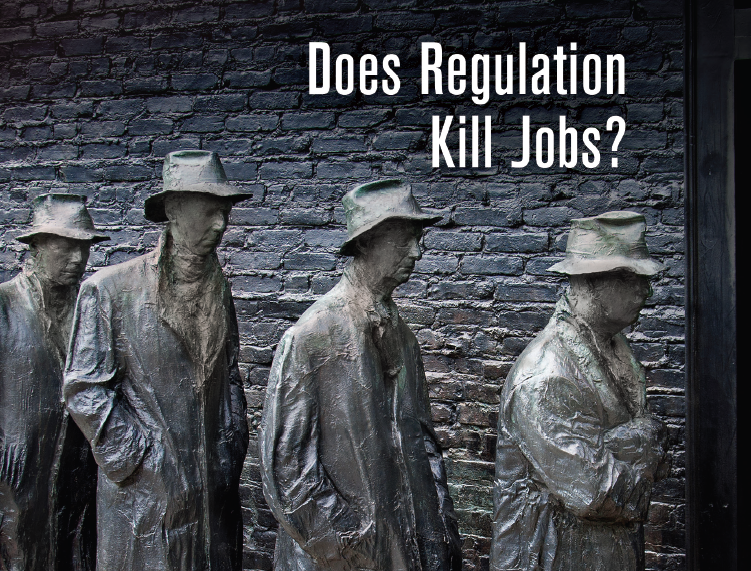
New book from Penn Program on Regulation explores the connection between regulation and employment.
Tens of millions of Americans continue to suffer the ravages of unemployment. Although government benefits have helped ease some of the pain, questions remain about what more government can do to help improve employment prospects in the United States. Can regulatory reform provide at least part of the answer?
In this series, The Regulatory Review considers this question by featuring essays organized around the recently-released book, Does Regulation Kill Jobs?, the latest research project of the Penn Program on Regulation.
Many Republican politicians think that regulations do kill jobs, and they argue that new health care, environmental, and financial rules should be either repealed or delayed until the economy returns to more robust levels of employment. Of course, just as many Democratic politicians argue that strong regulation is needed to both promote job growth and to deliver other important social benefits, including the prevention of another financial meltdown. Can both sides be right?
That’s why The Regulatory Review is featuring this series. Does Regulation Kill Jobs? casts important new light on one of the most heated policy debates of our time. It offers rigorous, analytical insights that, while they may not entirely support either partisan view, provide precisely the kind of direction needed if policymakers are truly to make better decisions about both regulation and employment.
Does Regulation Kill Jobs? is edited jointly by Penn Law Professor and PPR Director Cary Coglianese, PPR Executive Director Adam Finkel, and PPR’s inaugural Regulation Fellow Chris Carrigan, now on the faculty at George Washington University’s Trachtenberg School of Public Policy and Public Administration.
Our series begins with an introductory essay by two of the book’s editors, Cary Coglianese and Chris Carrigan. It then continues with essays highlighting key findings and arguments presented in five more of the new book’s fourteen chapters.
Informing the Debate over Regulation’s Impact on Jobs
March 10, 2014 | Christopher Carrigan & Cary Coglianese
This past Friday’s jobs report contained mixed news. On the positive side, the Department of Labor reported that employment grew in February by 175,000 jobs, which was more than expected. But the unemployment rate still remains high and actually increased slightly to 6.7 percent last month.
Analyzing Regulation’s Effect on Jobs
March 11, 2014 | Natalie Punchak
U.S. newspapers’ use of the phrase “job-killing regulations” has exploded in recent years, rising by 17,550% from 2007 to 2011, according to the Institute for Policy Integrity at the New York University School of Law. Yet are these claims true? Currently, little information is available on the extent to which regulations eliminate or create jobs.
Can Risk Assessment Help Us Determine if Regulations Kill Jobs?
March 12, 2014 | Edgar Mkrtchian
“Job-killing regulation” has become a popular part of our political lexicon: but are jobs actually killed by regulation? In his chapter in the new book Does Regulation Kill Jobs?, Adam Finkel suggests that lessons learned over the past 25 years from improving the quantitative risk assessment of environmental and health hazards can lead to better analyses of whether regulations kill jobs, create them, both, or neither.
The Unemployment Costs of Regulation
March 13, 2014 | Christian Latham
Do we really know how much regulations cost? When regulators calculate the value of proposed regulations, they typically employ a cost-benefit analysis (CBA) that compares the net benefits of the rule with the compliance costs borne by the regulated industry. New research, however, suggests that a simple CBA, which does not account for losses in human capital suffered by laid-off workers, may significantly underestimate the costs of some regulations.
A Better Way to Study the Effects of Regulation on Employment
March 17, 2014 | Jessica Bassett
In the wake of the Great Recession, recent political debates have focused on the impact regulation has on employment and economic recovery. But what actual impact does regulation have on the economy, and how can agencies account for employment in rulemaking?
The Democratic Case for Job Impact Analysis
March 18, 2014 | Natalie Punchak
When the EPA finalized its Mercury and Air Toxics Standards (MATS) and Cross-State Air Pollution Rule in 2011, the American Coalition for Clean Coal Electricity forecasted a 1.4 million job-year loss due to the costs the rules were expected to impose. By contrast, the Political Economy Research Institute predicted a 1.4 million job-year gain as a result of these same regulations.



